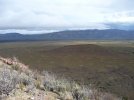- Joined
- Nov 7, 2012
- Messages
- 5,173
- Location (City and/or State)
- South of Southern California, but not Mexico

Hi,
This image is facing south towards the Grootswartberg Mountains. I was a few dozen kilometers east of Prince Albert in RSA.
The habitat image encompasses where three species were found over a few days of searching.
The hill the image is taken from as well as the hill most in the fore ground are where we found several leopard tortoises.
Chersine angulata use the the small seasonal riparian zones along the tree and creek line. These areas maintain slightly higher humidity, and have several succulents growing on the ground in and among woody shrubs. The small angulata in the bucket from a previous image post was hunkered down in and among a thick bed of succulents. The thicket of branches that are above the succulents reduce large hoofstock foraging animals from eating it all. This micro habitat in this otherwise sparse landscape is very different than just a few meters away from the zone that water flows in during the rainy season.
Though I did not witness this myself, I was told by area scientists that the angulata in this habitat restrict themselves to the stream beds and travel along them, up and down, from small to large, as the season changes, so their humidity needs are met. It's also where many things for them to eat persist in dry times.
The tent tortoises, Psammobates tentorius, in this area use the flat ground that is not so much the stream beds. They were found on the higher areas between the drainage areas (stream beds). The sorta white spots on the flat areas are ancient termite mound remains. The termites so thoroughly changed the small spots where their mounds had been that each of those patches has a very different group of plants on them, than the adjacent area where the soil is not white. This white soil is also much more dig-able, and many small animals have burrows their. These burrows are used by the tent tortoises. Those small white spots are several meters across.
So, in a very small area, a few kilometers across three species co-exist, they no doubt have some overlap, but they mostly seem to keep to the smaller subsets of these places as described.
If you have some question about things in the image please do ask.
Will
Last edited by a moderator: